The accounting staff of cce Enterpises has completed the financlal statements for the 2016 calendar year. The statement of incoene for the carrent year and the comparative statements of financial position for 2016 and 2015 follow. Comparative Statements of Financial Position December 31, 2016 and 2015 (thousands omitted) Assets 20162015 Current assets: Cash and short-term investments $25,930$21,160 Receivables, less allowance for doubtful accounts ($1,060 in 2016 and $1,350 in 2015) Inventories, at lower of FIFO cost or market Prepaid items and other current assets Total current assets Other assets: Investments, at cost Deposits Total other assets Property, plant, and equipment: Land $12,140$12,140 Buildings and equipment, less accumulated depreciation ( $126,940 in 2016 and $122,880 in 2015) Total property, plant, and equipment Total assets \begin{tabular}{rr} 5,030 & 3,000 \\ \hline$143,820 & $135,780 \\ \hline \end{tabular} $105,800$105,800 Liabilities and Owners' Equity Current liabilities: Short-term loans Accounts payable \begin{tabular}{c|c} 268,690 & 247,820 \\ \hline$280,830 & $259,960 \\ \hline$540,600 & $509,560 \\ \hline \end{tabular} Salaries, wages, and other Total current liabilities $21,70072,15026,1$24,17071,250 1. Calculate the following financial ratios for 2016 for CCB Enterprises: Round items h,J, and k to the nearest whole number. Round all other answers to two decimal places. Assume a 360-day year. a. Times interest earned b. Return on total assets c. Return on common stockholders' equity d. Debt-to-equity ratio (at December 31, 2016) e. Current ratio (at December 31, 2016) 1. Quick (acid-test) ratio (at December 31, 2016) 9. Accounts receivable turnover ratio (Assume that all sales are on credit.) h. Number of days' sales in receivables 1. Calculate the following financial ratios for 2016 for CCB Enterprises: Round items h,j, and k to the nearest whole number. Round all other answers to two decimal places. Assume a 360-day year. a. Times interest earned b. Return on total assets c. Return on common stockholders' equity d. Debt-to-equity ratio (at December 31,2016 ) e. Current ratio (at December 31, 2016) f. Quick (acid-test) ratio (at December 31,2016 ) g. Accounts receivable turnover ratio (Assume that all sales are on credit.) h. Number of days' sales in receivables i. Inventory turnover ratio (Assume that all purchases are on credit.) j. Number of days' sales in inventory k. Number of days in cash operating cycle










